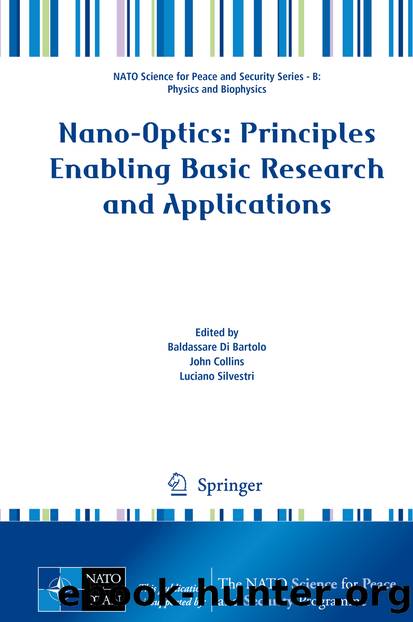Nano-Optics: Principles Enabling Basic Research and Applications by Baldassare Bartolo John Collins & Luciano Silvestri

Author:Baldassare Bartolo, John Collins & Luciano Silvestri
Language: eng
Format: epub
Publisher: Springer Netherlands, Dordrecht
13.
7310 s
73
77
2.27
100.7
99.7
Mean
98.0
97.1
1.3
0.4
The standard deviation of all the particle results determined using Eq. 11.8 (5.0 nm) is very close to the manufacturer’s standard deviation of 4.5 nm, implying that our standard deviation is the result of particle size variation, and not the computational approach.
11.5 Concluding Remarks
For the data in Table 11.1 X n = 0.9, which easily qualifies for testing our sizing technique based on g 1, [13] however it appears that g 2 provides better agreement with our data. The mean size arrived at using our global positioning scheme differs from 〈a m 〉 by deviations of about +1.3 % using g 1, and by + 0.4 % using g 2. It is not difficult to understand the superiority of g 2 over g 1.
Reference [13] suggests that the intensity in the numerator of Eq. 11.1 should be evaluated at the center of the nanoparticle so long as X n < 1. The upper limit in size consistent with this inequality is a max = λ/(2πnp), which for polystyrene particles at 1063 nm is about 108 nm. For the microcavity used in Table 11.1, L = 194.4 nm, so the intensity at the furthest part of the bound nanoparticle is only 33 % of what it is at the microcavity surface. This is expected to lead to a decidedly inhomogeneous energy density within the particle. In other words the centroid of energy density within the particle cannot be at the center as it would be for a uniform intensity; considering the current high precision of our measurements, a point dipole model is less reasonable than the shape dependent Born approximation even for X n < 1.
To further support our conclusion a COMSOL simulation was performed for microcavity and nanoparticle parameters similar to those in Table 11.1. Figure 11.3 shows a typical calculation. The intensity within the particle falls off by a factor of 2.87 from the closest point to the microcavity to the furthest point even though Xn <1. This image allows us to calculate the total polarization energy of the particle. The results are consistent with the RSP theory for a non-uniform polarization density, [18] and with the use of the form factor g2 [19].
Fig. 11.3COMSOL calculation showing the internal field within a 96.7 nm radius polystyrene particle located at the equator of a spheroidal resonator and bathed in a TE field of a 1st order WGM with l = 340. The position of the vertical white line closest to the nanoparticle represents the surface of the microcavity. The intensity within the particle falls off by a factor of 2.87 from the closest point to the microcavity to the furthest point even though Xn <1
Download
This site does not store any files on its server. We only index and link to content provided by other sites. Please contact the content providers to delete copyright contents if any and email us, we'll remove relevant links or contents immediately.
| Automotive | Engineering |
| Transportation |
Whiskies Galore by Ian Buxton(41530)
Introduction to Aircraft Design (Cambridge Aerospace Series) by John P. Fielding(32888)
Small Unmanned Fixed-wing Aircraft Design by Andrew J. Keane Andras Sobester James P. Scanlan & András Sóbester & James P. Scanlan(32573)
Craft Beer for the Homebrewer by Michael Agnew(17933)
Turbulence by E. J. Noyes(7700)
The Complete Stick Figure Physics Tutorials by Allen Sarah(7141)
Kaplan MCAT General Chemistry Review by Kaplan(6595)
The Thirst by Nesbo Jo(6436)
Bad Blood by John Carreyrou(6275)
Modelling of Convective Heat and Mass Transfer in Rotating Flows by Igor V. Shevchuk(6223)
Learning SQL by Alan Beaulieu(6035)
Weapons of Math Destruction by Cathy O'Neil(5829)
Man-made Catastrophes and Risk Information Concealment by Dmitry Chernov & Didier Sornette(5647)
Digital Minimalism by Cal Newport;(5389)
Life 3.0: Being Human in the Age of Artificial Intelligence by Tegmark Max(5184)
iGen by Jean M. Twenge(5161)
Secrets of Antigravity Propulsion: Tesla, UFOs, and Classified Aerospace Technology by Ph.D. Paul A. Laviolette(4992)
Design of Trajectory Optimization Approach for Space Maneuver Vehicle Skip Entry Problems by Runqi Chai & Al Savvaris & Antonios Tsourdos & Senchun Chai(4840)
Electronic Devices & Circuits by Jacob Millman & Christos C. Halkias(4748)
